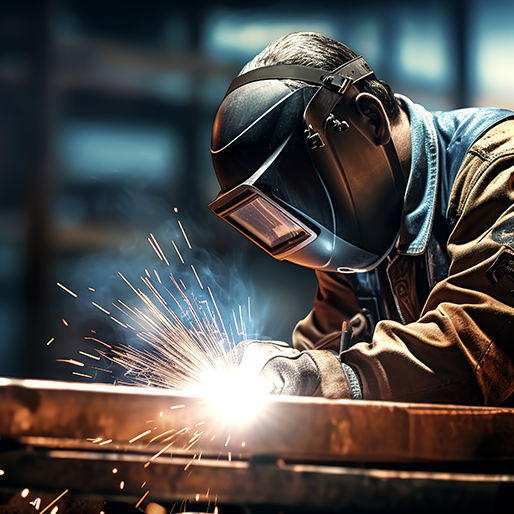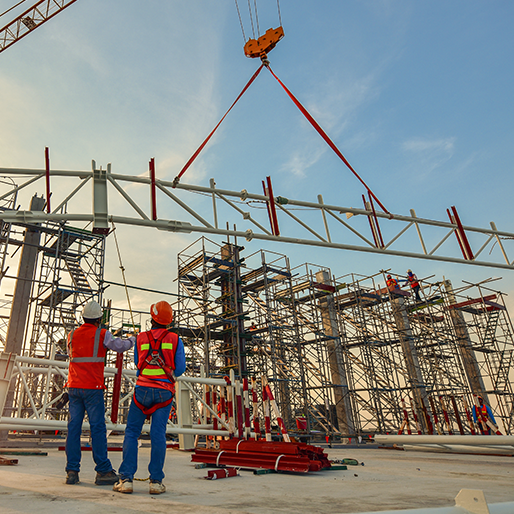Modified on
Future Trends in Steel Structures: Advanced Materials & Construction Techniques

Skill-Lync

As the world marches forward into the future, the realm of steel construction is poised to witness remarkable advancements. Pioneering materials and construction techniques are reshaping the landscape of steel structures, pushing the boundaries of engineering excellence.
Discover the cutting-edge developments and prospects of steel structures as we delve into this article. If you're intrigued, continue reading for an insightful journey!
The evolution of steel structures
Steel has been a vital material in the construction industry for centuries, and its evolution over time has significantly impacted the way buildings and structures are designed and built. From the early days of iron and steel production to modern high-rise structures, the evolution of steel structures has been marked by technological advancements and innovative design approaches.
- The history of steel structures can be traced back to the 6th century BCE when cast iron was first used in construction. However, it was the development of the Bessemer process in the mid-19th century that revolutionized steel production by enabling large-scale production of high-quality steel at lower costs. This breakthrough paved the way for the widespread use of steel in construction.
- One of the key milestones in the evolution of steel structure construction was the advent of the steel frame system in the late 19th century. This system, which involved using steel columns and beams to support the load of the building, allowed for taller and more robust structures. The construction of iconic structures such as the Eiffel Tower and the Home Insurance Building in Chicago, often considered the first skyscraper, showcased the potential of steel in pushing the limits of architectural design.
- In the 20th century, the development of new steel alloys and fabrication techniques further enhanced the strength and versatility of steel structures. The introduction of structural steel shapes, such as the I-beam, and advancements in welding technology allowed for more efficient and cost-effective construction methods.
- Recent trends in steel structures design; the evolution of steel structures has been driven by a focus on sustainability and energy efficiency. The use of recycled steel in construction has gained prominence, reducing the environmental impact of steel production. Additionally, innovative design techniques, such as the integration of steel with other materials like glass and concrete, have led to the creation of visually stunning and structurally efficient buildings.
- The evolution of steel structures continues to evolve with the advancements in Computer-Aided Design (CAD) and Building Information Modeling (BIM), which enable architects and engineers to optimize the structural performance of steel buildings. Furthermore, the incorporation of smart technologies, such as sensors and monitoring systems, allows for real-time assessment of structural integrity and predictive maintenance.
As we look to the future, further advancements in materials science, design innovation, and sustainable practices will continue to shape the evolution of steel structures, creating safer, greener, and more efficient buildings.
Future applications of steel structures
Following are the future trends of steel structure drawing:
- Advanced composite materials: The future of steel structures lies in the integration of advanced composite materials. These materials offer higher strength-to-weight ratios and improved corrosion resistance, allowing for the construction of lighter, more durable steel structures
- Smart and responsive steel structures: With advancements in sensor technology and data analytics, steel structures of the future will be equipped with smart systems that can monitor their structural health in real-time. This will enable proactive maintenance, early detection of defects, and increased safety.
- 3D printing of steel structures: Additive manufacturing techniques, such as 3D printing, are revolutionizing the construction industry. In the future, steel structures could be printed on-site, reducing the need for transportation and assembly. This technology also offers the potential for complex and customized steel structure designs.
- Self-healing steel: Researchers are exploring the development of self-healing steel, which can repair small cracks or damage automatically. This innovative material could significantly extend the lifespan of steel structures, reduce maintenance costs, and enhance structural resilience.
- Energy harvesting and efficiency: Future steel structures may incorporate energy harvesting technologies to generate power from renewable sources, such as solar panels integrated into building facades or wind turbines mounted on tall steel towers. Additionally, advanced insulation and energy-efficient designs will improve overall energy performance.
- Multi-functional steel structures: Steel structures of the future will be designed to serve multiple purposes. For example, bridges could incorporate built-in transportation systems, such as automated vehicles or dedicated bicycle lanes. Buildings might feature integrated green spaces or vertical farming systems to maximize land use and promote sustainability.
- Modular and adaptable designs: Steel structures are inherently flexible and modular, allowing for easy expansion, modification, or relocation. In the future, this adaptability will be further emphasized, enabling faster construction times, reduced waste, and improved scalability.
- Integration of robotics and automation: The future of steel structures will see increased utilization of robotics and automation in the construction process. Robots can perform tasks such as welding, cutting, and assembly with precision and efficiency, leading to safer work environments and faster project completion.
Moving on, let us look at the complicacy and rewards in future steel construction.
Challenges and opportunities: Implementing future trends in steel construction

Below we will explore some of the key areas where advancements are being made and highlight the potential obstacles and benefits associated with these developments.
-
Sustainability and environmental concerns:
One of the foremost challenges in steel construction is addressing sustainability and environmental concerns. The industry is under increasing pressure to reduce its carbon footprint and adopt eco-friendly practices. Opportunities lie in the development of innovative processes, such as low-carbon steel production, recycling and reuse of steel components, and the integration of renewable energy sources in steel manufacturing plants.
-
Digitalization and Building Information Modeling (BIM):
The adoption of digitalization and Building Information Modeling (BIM) presents both challenges and opportunities for the steel construction industry. Integrating BIM with steel fabrication processes can enhance efficiency, reduce errors, and streamline communication between stakeholders. However, implementing BIM requires significant investment in technology, training, and standardized data exchange protocols.
-
Advanced Materials and Manufacturing Techniques:
The emergence of advanced materials, such as high-strength steel and composite materials, offers opportunities to enhance the structural performance and durability of steel constructions. Additionally, advancements in manufacturing techniques like 3D printing and robotic welding enable the fabrication of complex and customized steel components with improved precision and cost-effectiveness. However, challenges arise in optimizing these materials and techniques for large-scale applications, ensuring quality control, and navigating regulatory requirements.
-
Resilience and safety:
As the world faces more frequent and severe natural disasters, the resilience and safety of steel structures become paramount. Implementing future trends involves integrating resilient design principles, such as earthquake-resistant and fire-resistant technologies. However, challenges arise in balancing cost-effectiveness, design complexity, and the need for continuous improvement in safety standards.
Conclusion
With this we have come to the end of this topic; we hope we were able to provide you with a thorough understanding of what the future of steel structure looks like. If you like reading this article, we have plenty more articles on Civil engineering for you to explore. If you're interested, you can check them out as well.
Pursuing a career in civil engineering holds immense potential and offers a wide range of opportunities. However, to excel in this field and stay ahead of the competition, acquiring additional skills and knowledge is crucial. Skill-Lync courses provide a comprehensive platform for aspiring civil engineers to enhance their expertise, gain practical insights, and bridge the gap between theoretical knowledge and industry demands. By enrolling in these courses, individuals can equip themselves with the necessary tools to thrive in the dynamic world of civil engineering and build successful careers.
Author
Navin Baskar
Author

Skill-Lync
Subscribe to Our Free Newsletter

Continue Reading
Related Blogs
To understand how a building is constructed or how a machine operates, engineers need to be proficient in technical knowledge. However, the Indian education system fails to inculcate deemed industrial expertise. This calls for engineering graduates and freshers to upskill and become familiar with technical drawings. With Skill-Lync's Masters in High-Rise Building Design and Analysis you will be able to get recruited by an organization in the domain of civil engineering.
29 Jul 2020
This is the continuation of the article on Civil and Architectural Drafting using AutoCAD. In the second part of the series, we take a closer look at AutoCAD and the various tools and processes that help you design and estimate constructions. After enrolling in Skill-Lync's Master's in High-Rise Building Design and Analysis, your dream of working in the Civil Engineering domain is just a hair-breadth away.
29 Jul 2020
Don't miss out on any of the new job openings in your domain. This job report is relevant to all engineers with a background in Civil & Architectural Engineers
30 Sep 2021
Thanks to COVID-19, engineering students are losing their scope of acing their dream jobs. But amidst it all, Skill-Lync's students have a bright outlook, as they are yet working on industry-relevant projects to upskill their portfolios. Learn more about Skill-Lync students and their productivity in these challenging times.
24 Aug 2020
This introduction to BIM will help you understand the world of BIM and its fundamentals, which include levels, dimensions, and LOD. You will also learn the significance and the uses of BIM, along with its benefits. Additionally, you will learn why BIM is better than conventional processes.
16 Nov 2020
Author

Skill-Lync
Subscribe to Our Free Newsletter

Continue Reading
Related Blogs
To understand how a building is constructed or how a machine operates, engineers need to be proficient in technical knowledge. However, the Indian education system fails to inculcate deemed industrial expertise. This calls for engineering graduates and freshers to upskill and become familiar with technical drawings. With Skill-Lync's Masters in High-Rise Building Design and Analysis you will be able to get recruited by an organization in the domain of civil engineering.
29 Jul 2020
This is the continuation of the article on Civil and Architectural Drafting using AutoCAD. In the second part of the series, we take a closer look at AutoCAD and the various tools and processes that help you design and estimate constructions. After enrolling in Skill-Lync's Master's in High-Rise Building Design and Analysis, your dream of working in the Civil Engineering domain is just a hair-breadth away.
29 Jul 2020
Don't miss out on any of the new job openings in your domain. This job report is relevant to all engineers with a background in Civil & Architectural Engineers
30 Sep 2021
Thanks to COVID-19, engineering students are losing their scope of acing their dream jobs. But amidst it all, Skill-Lync's students have a bright outlook, as they are yet working on industry-relevant projects to upskill their portfolios. Learn more about Skill-Lync students and their productivity in these challenging times.
24 Aug 2020
This introduction to BIM will help you understand the world of BIM and its fundamentals, which include levels, dimensions, and LOD. You will also learn the significance and the uses of BIM, along with its benefits. Additionally, you will learn why BIM is better than conventional processes.
16 Nov 2020
Related Courses
